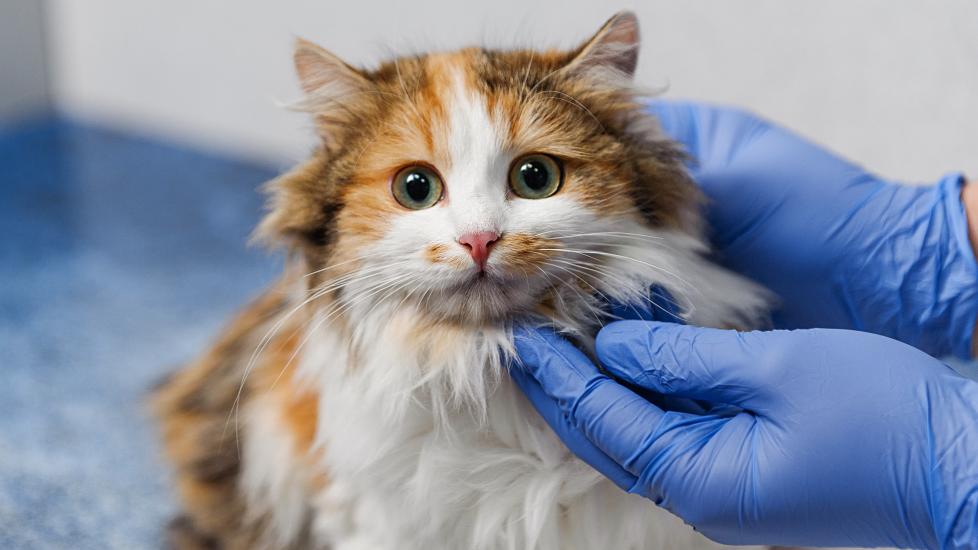Nausea in Cats
Cats can show signs of nausea that can range from subtle to obvious. Because they can’t tell you how they’re feeling, it’s up to you to watch for these signs and learn when to seek veterinary help so the cause can be found and treated.
Symptoms of Nausea in Cats
Cats can hide illness very well, so you’ll need to pay close attention to any subtle changes in their behaviors. Symptoms of nausea in cats include:
-
Hypersalivation (too much saliva) or drooling
-
Not eating as much or at all
-
Licking or smacking their lips
-
Retching without throwing up
-
Lethargy or tiredness
-
Increased vocalization (meowing or yowling)
-
Hiding or less interest in interacting with people and other animals
-
Overgrooming or licking abnormal things, such as floors
What To Do if Your Cat Has Signs of Nausea
It’s extremely important to bring your cat to a veterinarian as soon as possible if you notice any of these signs of nausea in your cat and:
-
They do not resolve within 24 hours
-
Your cat starts vomiting
-
Your cat has not eaten for 24 hours or more
-
Your cat has severe lethargy, diarrhea, unexplained weight loss, trouble urinating, or trouble breathing
If your regular veterinarian is not open or too busy to see them, they will usually recommend that you take your cat to an emergency hospital as soon as possible.
If your kitty shows short-lived signs of nausea (less than 24 hours), has very mild signs, or these signs come and go but your cat is still eating and alert, then it is OK to schedule an appointment with your regular veterinarian for an examination, testing, and treatment. Your cat should be seen within 48 hours.
What Causes Nausea in Cats?
Unfortunately, nausea is a vague clinical sign that can be caused by many medical issues ranging from mild to severe. The most common causes are:
-
Switching to a new food or new treats too fast
-
Eating human foods that can cause belly upset
-
Hairballs (often from overgrooming or shedding)
-
Food allergies/hypersensitivities
-
Viral infections such as panleukopenia or feline infectious peritonitis
-
Swallowing a non-food item that can get stuck in the gastrointestinal tract
-
Intestinal parasites (worms)
-
Cancer of the gastrointestinal tract
-
Toxin ingestion (such as pesticides, ethylene glycol, certain plants)
-
Certain medications such as chemotherapy, antibiotic therapy, or steroids
-
Motion sickness
-
Infection of the uterus (pyometra)
-
Vestibular disease (vertigo)
-
Brain tumors
How Vets Diagnose the Cause of Nausea in Cats
Sometimes nausea can resolve on its own. But often, it requires an investigation into the underlying cause to figure out the best course of treatment.
Your veterinarian will ask questions about your cat’s diet, recent diet changes, and access to the outside, or if you’ve noticed any missing toys or pieces of toys.
They will then perform a physical examination to check for pain, abdominal distention (enlargement), muscle wasting/weight loss, thyroid enlargement, mouth ulcers, and neurologic status.
Based on what they learn, your veterinarian will likely recommend some of the following tests:
-
Full bloodwork to check for kidney disease, liver disease, diabetes, hyperthyroidism, abnormal protein levels, electrolyte abnormalities, and changes in red and white blood cell counts
-
Urine testing to check for kidney disease and urinary tract infection
-
Abdominal imaging—such as X-rays or ultrasound—to check the abdominal organs. This imaging is helpful in looking for foreign body ingestion/blockage, pyometra, gastrointestinal tumors, constipation, pancreatitis, and kidney and liver issues.
-
Fecal testing to help rule out intestinal parasites such as worms, certain bacteria (E. coli, clostridium, salmonella), giardia, and coccidia
-
Viral testing to help rule out feline leukemia, feline immunodeficiency virus, and possibly other viruses (such as FIP or panleukopenia).
-
Endoscopy: This is a more aggressive test that is done under general anesthesia to directly check the inner lining of the stomach and upper small intestine for tearing, tumors, or swelling.
Treating Nausea in Cats
Treatment of nausea is based on the cause, the severity of symptoms, how easy it is to medicate your cat, and how long they’ve had symptoms. Treatment can range from oral antacids (such as famotidine or omeprazole) and anti-nausea medications (such as Cerenia or ondansetron) to hospitalization with injectable medications and intravenous (IV) fluid therapy.
Unfortunately, there are no recommended home remedies for cats with nausea. Your veterinarian may recommend trying an over-the-counter dose of famotidine (name brand: Pepcid AC) if your cat’s signs are mild and they’ve only had one or two episodes of vomiting. They may also discuss a brief change to a bland, easily digestible diet to see if the symptoms improve or not.
How To Prevent Nausea in Cats
Preventing nausea in cats also depends on the cause. In some cases, it can be as easy as consistency. A consistent diet, environment, and interaction with other people and animals is best when it comes to cats. Their bodies are not built for frequent change, and they can show signs of nausea when things do change.
-
Feed your cat a diet that’s recommended by your veterinarian and don’t switch it too often.
-
Brush your cat often to avoid matting, especially during season changes, to avoid hairballs.
-
Make sure you don’t have any toxic houseplants or small toys (especially with strings) to prevent your cat from eating these objects.
-
Keep your cat indoors to avoid interaction with feral animals or, if they are outdoor prowlers, keep them up to date on their vaccines to avoid viral transmission.
Keeping a close eye on any changes in your cat’s normal behavior is very important, especially when the signs of nausea in cats can be so subtle. If you notice prolonged signs of nausea or other concerning symptoms, take your cat to a veterinarian to have them treated as soon as possible.
Featured Image: Adobe/flywish
